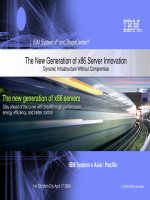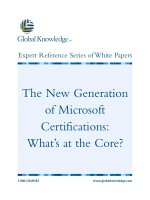Email benchmark report the new age of email marketing
Bạn đang xem bản rút gọn của tài liệu. Xem và tải ngay bản đầy đủ của tài liệu tại đây (3.51 MB, 15 trang )
pa
ss
Q
ar 1 2
ke 0
t in 1 7
g
Co
m
M
ai
l
Em
The New Age of
Email Marketing
Embracing the
Subscriber Influx
Executive Overview
Over the last decade, consumers have grown increasingly overwhelmed by the sheer number of email marketing
messages in their inbox. In fact, when Gmail introduced its promotions tab in 2013 to help users make sense of all
the incoming content, many marketers feared that their campaigns would go unseen and that the email channel
would lose effectiveness.
But according to Yes Lifecycle Marketing data from Q1 2017, four years after the launch of Gmail’s promotions tab,
most of these fears turned out to be unfounded. Consumers want to receive and open marketing emails regardless
of how flooded their inboxes may be.
However, consumer engagement (unique click and click-to-open rates) continues on a steep decline, which means
that brand messages do little to encourage subscribers to click through and engage beyond the open.
This drop in engagement is the trend marketers should focus on reversing in 2017; after all, email ROI depends on
consumers clicking through emails. Successful brands are increasingly turning to triggered campaigns while also
considering day of the week and industry trends. In this report, we highlight the importance of these email tactics
and offer actionable tips for brands to meet the evolving subscriber expectations.
1.877.937.6245 | | www.yeslifecyclemarketing.com | pg. 1
Q1 Benchmarks
THE NEW AGE OF EMAIL MARKETING
Key findings from this quarter:
• New subscribers make up a greater portion of marketers’ email audience: New subscribers made up 6
percent of marketers’ subscriber base, up 8 percent year over year (YoY) and up 30 percent over the last three
years.
• Open rates increased: The average open rate is now 16.1 percent, a 9 percent YoY increase and a 3% increase
over the last two years.
• Click-to-Open rates are on the decline: The average click-to-open rate (CTO) is 8.9 percent, a 13 percent
decrease YoY and a 22 percent drop over the last two years.
• Unique click rates dropped: The average unique click rate declined by 6 percent YoY and 20 percent over the
last two years.
• Triggers lead to significant ROI: Triggers made up just under 7 percent of total campaigns in Q1, yet they
generated almost 5 times the click rate, almost double the open rate, and almost triple the CTO rate of
business-as-usual (BAU) emails.
• Day of the week matters: Saturdays garnered the highest conversion rates with 2.4 percent of all email clicks
turning into a purchase, and this number jumps to 8 percent for triggered campaigns. Fridays saw the highest
unique click and click-to-open rates.
This is the new age of email marketing:
If the timing is right and the content is relevant, your subscribers are ready to listen.
1.877.937.6245 | | www.yeslifecyclemarketing.com | pg. 2
Q1 Benchmarks
THE NEW AGE OF EMAIL MARKETING
Consumers want your emails!
According to data from more than 7 billion emails sent in Q1, the new age of email marketing involves eager
consumers ready to communicate with brands via email, as long as the content is relevant to their needs and
interests at the time.
One metric that defines the new age of email marketing is a growing number of new subscribers within brand
email lists. New subscribers now make up 6 percent of marketers’ subscriber base. That’s an 8 percent increase
YoY and a 30 percent increase over the last three years.
The growing number of new subscribers might be prompted by utilitarian needs – when consumers have a need
for specific items, they join a brand’s mailing lists to get immediate offers. For instance, a consumer looking for
patio furniture from a home goods retailer might see a pop-up window when she visits the retailer’s site offering
a percent off discount in exchange for her email address. She opts into the retailer’s mailing program to get the
discount for the furniture she’s looking to buy immediately.
Despite years of speculation that consumers are growing wary of marketing emails, the data suggests otherwise.
The growing number of new subscribers means both willingness to subscribe to and willingness to open marketing
emails. Even if they don’t have an immediate need, some consumers sign up because they like the brand, and feel
its content is relevant. Bottom line: if they anticipate that the emails will be contextually relevant, they’ll subscribe.
Percentage of new subscribers
in brand databases by quarter
4.1%
6.8%
Q1 | 2014
5.6%
Q1 | 2016
Q1 | 2015
6.1%
Q1 | 2017
1.877.937.6245 | | www.yeslifecyclemarketing.com | pg. 3
Q1 Benchmarks
THE NEW AGE OF EMAIL MARKETING
Another metric that illustrates the new age of email marketing is increasing open rates. The average open rate has
registered an increase for the second quarter in a row after several quarters of mild decline. The average open rate
is now 16 percent, a 4 percent increase QoQ and a 9 percent increase YoY.
Higher open rates mean that when consumers have a need, they are willing to sieve through emails to find the right
product and offer. The consumer looking for patio furniture will open emails from a home goods brand advertising
a sale on the products she’s browsed, or one offering a general discount at the time she’s looking to buy. This is
another great lesson for marketers: consumers will seek out your emails when the time and content are right for
them.
Open Rate by Quarter
18%
17%
16%
15.7%
15.0%
15%
15.4%
14.8%
14.8%
14.8%
14.6%
14.3%
Q3
2015
Q4
2015
Q1
2016
Q2
2016
Q3
2016
16.1%
14%
13%
12%
Q1
2015
Q2
2015
Q4
2016
Q1
2017
More new subscribers and rising open rates sound great, right? Not so fast. For this to truly mean good news, these
metrics must also translate into higher engagement (in the form of increasing unique click rates and click-to-open
rates). However, consumers engage less with email now than they did three years ago. In fact, the average click-toopen rate decreased 13 percent YoY and 22 percent since 2015. Unique click rates follow the same pattern. They’ve
declined 6 percent YoY and 20 percent over the last two years.
So even though consumers are signing up for emails and opening them, the rate at which they engage with
marketing messages (think: clicking through to the brand’s site) remains stagnant.
Click-to-Open Rate by Quarter
12.0
11.5%
11.4%
11.5%
11.3%
11.0%
10.9%
10.2%
10.5%
10.0%
9.7%
9.9%
9.5%
9.0%
8.9%
8.9%
Q4
2016
Q1
2017
8.5%
Q1
2015
Q2
2015
Q3
2015
Q4
2015
Q1
2016
Q2
2016
Q3
2016
1.877.937.6245 | | www.yeslifecyclemarketing.com | pg. 4
Q1 Benchmarks
THE NEW AGE OF EMAIL MARKETING
Recommendation:
Despite higher open rates, email content across the board is not engaging enough to motivate subscribers to click
through to a brand’s website, which can lead to declining conversion rates and a loss of revenue over time.
In order to boost engagement, and ultimately conversions, brands must do more to encourage subscribers to click
through. This means offering valuable, relevant information that meets the needs of the audience at the time and is
personalized to each subscriber.
Home Depot recently sent a campaign about the plants that are in season based on each subscriber’s location
along with recommendations for projects to do with each type of plant. This immediately captures the audience’s
attention and is a welcome departure from typical promotional emails. The brand did a great job of bringing the
messaging back to its products by offering recommendations like gardening tools and other supplies.
To bring back the patio furniture example, moving forward the home goods brand needs to target this shopper
with content that is relevant to her, otherwise she’ll disengage. Cookie-cutter offer emails (i.e. those advertising a
percent or dollar amount off) are not enough to keep her engaged long-term, so the brand needs to adapt to her
channel preferences, personalize offers based on browse and purchase history and send unique content informed
by her interests and demographic information. This could be a value-added message with grilling recipes for her
outdoor party (celebrating her new patio furniture) or a list of family-friendly outdoor activities if she’s a mom.
1.877.937.6245 | | www.yeslifecyclemarketing.com | pg. 5
Q1 Benchmarks
THE NEW AGE OF EMAIL MARKETING
Here are a few ways to create engaging content:
Be unique and consider context: Email content doesn’t have to be dry. Have fun with your message, as long as
it’s relevant to your audience and takes into account a unique characteristic about them. In the Netflix example
below, the brand offered content that would instantly engage House of Cards fanatics and appeal to their specific
interest in the Netflix original show. The brand announced the release of a new House of Cards season with an
email coming from the show’s main character, instead of sending a basic notification. While this example may not
translate directly to all industries, brands can take note of the unique, tailored approach, which centers on the way
consumers engage with the Netflix brand: through characters and storytelling.
Incorporate lifecycle communications: Reach
subscribers with personalized messaging based
on their customer lifecycle stage. Did they recently
sign up for your mailing program? Send them an
offer as a thank you. Did they visit your site but not
convert? Follow up with an email reminder of what
they were looking at and highlight other relevant
products.
Identify appropriate channel touch points:
Consider supplementing email with other channels
such as SMS, direct mail or social depending on
your subscribers’ preferences. For a subscriber
who engages with SMS at high rates, swap
your email offers with SMS. And make
sure that the content is consistent across
both channels and that offers can be
easily redeemed online or in-store. In the Home
Depot example, if a subscriber recently purchased
gardening tools and you know she engages with
SMS, send her a text with exclusive offers for
in-season plants in her area.
Personalize timing and frequency: Use
preference centers to enable subscribers
to select the appropriate message frequency.
Explore tools that can help optimize send times
based on consumer data like location or highest
likelihood to engage. This is a great way to nail
down the best time a message should reach
each subscriber thus maximizing opens and
engagement.
1.877.937.6245 | | www.yeslifecyclemarketing.com | pg. 6
Q1 Benchmarks
THE NEW AGE OF EMAIL MARKETING
Triggers: Low risk, high reward
One of the most effective ways for brands to deliver engaging content is through timely triggered campaigns,
informed by specific consumer actions or data and deployed within a set timeframe. Triggers are designed to
elicit an immediate response. For example, brands could send triggered emails to subscribers who abandon their
shopping carts, or to broader audiences like Chicago-based consumers who might be enticed by relevant offers
following the Cubs’ World Series win.
Triggers make up just under 7 percent of total campaigns marketers send, yet they generate almost 5 times the
click rate, almost double the open rate, and almost triple the CTO rate. Additionally, the average order value for BAU
retail emails is $56.34, compared to $61.54 for triggered messages. Marketers are missing a huge opportunity to
drive engagement and conversions by not deploying more triggered campaigns.
Performance of Triggered vs Business as Usual (BAU) Communications
Open Rates
Click-to-Open Rate
Unique Click Rates
21.6%
27.6%
28%
22%
8%
26%
20%
7%
24%
18%
6%
22%
16%
5%
20%
14%
4%
12%
3%
18%
15.3%
8.4%
16%
10%
14%
8%
1%
12%
6%
0%
BAU
2%
6.0%
1.3%
Triggered
1.877.937.6245 | | www.yeslifecyclemarketing.com | pg. 7
Q1 Benchmarks
THE NEW AGE OF EMAIL MARKETING
Types of triggers include:
Transactional: Emails in response to transactions garner the highest open rates, making them a must for
marketers with ecommerce websites (or even exclusively physical locations). Thank a consumer for his purchase,
send a receipt, and offer personalized recommendations for other products that supplement his new item.
Remarketing: Remind subscribers of the items they left in their shopping cart or browsed through. Pair the
reminder email with customer testimonials or reviews of the featured product, or offer a personalized discount to
those who make a purchase within the next 24 hours. Remarketing triggers also provide an opportunity for brands
to cross-sell relevant products based on consumers’ browse and/or purchase history.
Customer lifecycle: Customer lifecycle events include new subscriber sign-ups, first-time purchases, loyalty
program memberships, anniversaries, and more. Brands can acknowledge and celebrate their customers’ lifecycle
stages with a triggered message designed to build loyalty and trust. For example, when consumers sign up for your
email program, offer them a discount as a thank you to encourage them to immediately convert to purchasers.
Real-time: Reach groups of subscribers based on real-time events. Most often, these
triggered emails are based on location. For example, brands could offer relevant items to consumers in New York in
advance of a big snowstorm, or in Boston after the Patriots won the Super Bowl.
Transactional
Remarketing
Lifecycle
Real-time
1.877.937.6245 | | www.yeslifecyclemarketing.com | pg. 8
Q1 Benchmarks
THE NEW AGE OF EMAIL MARKETING
Due to the unquestionable value of triggered emails, brands are increasingly incorporating them into their
programs. For example, while 65 percent of marketers had adopted welcome campaigns in Q1 2016, that number
grew to 72 percent over the last year. Since welcome triggers tend to be the first trigger marketers adopt, it’s
encouraging to see it on track to becoming universally used. Similarly, browse abandon and abandoned cart emails
grew in adoption.
Transactional triggers are also gaining traction. These types of triggers (in response to a recent purchase) are
great because they offer more room for personalization and cross-sell opportunities. So if a subscriber purchases
patio furniture from a home goods brand, the brand could send recommendations for grills or outdoor decorations
within the e-receipt email. In Q1 of 2016, 18 percent of brands sent e-receipts and 14 percent sent order/shipping
confirmations through their ESP while in Q1 2017, those numbers were 23 percent and 17 percent, respectively.
The relatively low number of transactional emails (it’s likely that most brands use them, yet our data shows
that only about one in four do) could be because many marketers default to their e-commerce platform to send
these types of communications instead of their ESP. If this is the case for you, beware: e-commerce platforms
can be inflexible, offer only rudimentary design and have major challenges with integrating data that supports
personalization and cross-selling.
Abandoned cart
Q1 2016
18.7%
Anniversary
Q1 2017
21.5%
Q1 2016
4.4%
Browse abandon
Q1 2016
5.8%
Birthday
Q1 2017
6.5%
Q1 2016
14.8%
Welcome
E-receipt/purchase confirmation
Q1 2017
7.4%
Q1 2016
18.1%
Order/shipping confirmation
Q1 2016
14.2%
Q1 2017
17.0%
Q1 2017
14.8%
Q1 2016
64.2%
Q1 2017
23.0%
Q1 2017
71.9%
Reactivation
Q1 2016
19.4%
Q1 2017
23.0%
1.877.937.6245 | | www.yeslifecyclemarketing.com | pg. 9
Q1 Benchmarks
THE NEW AGE OF EMAIL MARKETING
Recommendation:
Triggered messages are a great way for marketers to boost engagement and encourage subscribers to take
immediate action; they drive engagement because they are:
•Timely: Customers receive them immediately after they take an action.
•Relevant: The content is personalized to the recipient.
•Informed: The message is informed by customer data.
•Actionable: There is a clear call-to-action for the recipient.
While triggers account for a tiny portion of marketers’ sending volume, they yield a huge return on investment as
illustrated by higher engagement rates and higher average order values. Growing adoption of triggers indicates that
savvy marketers are starting to realize the benefits of these types of campaigns.
In fact, triggers are so effective that each incremental trigger brands add to their marketing programs will improve
overall performance and KPIs. Given the higher average order value and engagement for triggered emails,
marketers can actually earn 2.8 percent more revenue from each additional trigger they implement and deploy.
While brands should always consider the type of content that will resonate with their unique subscriber base,
introducing triggers is appropriate for almost every mailing program.
1.877.937.6245 | | www.yeslifecyclemarketing.com | pg. 10
Q1 Benchmarks
THE NEW AGE OF EMAIL MARKETING
Everybody’s working for the weekend
Another way brands can combat declining engagement rates is by tracking and analyzing day of the week email
engagement and conversion patterns. In Q1, Friday was the best day of the week for engagement, while Saturdays
garnered the highest conversion rates.
This trend is likely the result of consumers converting over the weekend when they have ample time to act on
emails they received over the rest of the week, particularly on Fridays. Saturdays have been the best for conversion
for three out of the last four quarters. The only exception, logically, was Q4 2016 when massive retail holidays like
Black Friday and Cyber Monday drove the highest conversion rates on those days.
Engagement by Day of the Week
Q1 2017
Open
Rate
Unique Click
Rate
Total Click
Rate
Click-to-Open
Rate
Conversion
Rate
Mon
14.7%
1.3%
1.8%
8.7%
2.4%
Tues
15.4%
1.2%
1.7%
7.6%
2.5%
Wed
14.7%
1.3%
1.9%
9.1%
1.8%
Thurs
15.5%
1.5%
2.1%
9.8%
1.9%
Fri
18.2%
2.0%
2.9%
10.8%
2.5%
Sat
14.9%
1.1%
1.6%
7.5%
3.6%
Sun
15.6%
1.2%
1.7%
7.9%
2.4%
AVERAGE
15.7%
1.4%
2.0%
9.0%
2.4%
1.877.937.6245 | | www.yeslifecyclemarketing.com | pg. 11
Q1 Benchmarks
THE NEW AGE OF EMAIL MARKETING
Recommendation:
Deploying campaigns on the right day of the week can lead to a significant ROI increase. Even though every brand
is different depending on industry, subscriber base, and business objectives, there is plenty of value for marketers
to keep a close eye on when their audience is most likely to engage with their campaigns and, equally as important,
convert.
A solid email program can include multiple emails deployed throughout the week, depending on each subscriber’s
frequency settings (as defined in the preference center). However, marketers will be smart to incorporate Fridays in
their mailing schedules given the high engagement on this day and the high conversion on the following.
One way marketers can take advantage of the high performance of Fridays and Saturdays is to opt for sending
some of their best-performing campaigns on those days. This could be a two-for-one for savvy brands that can
amplify the performance of already high-performing messages and generate more revenue due to the high
conversion rates on Saturdays.
Consumers are clicking emails and browsing on Fridays but converting on Saturdays -- either in-store or online. The
easier it is for subscribers to act on an email when the time is right, the greater the chance for them to purchase.
To maximize conversion, marketers should ensure their Friday emails include a clear call to action, and an easy
process for redeeming offers.
FRIDAY
SATURDAY
Convert
Click
1.877.937.6245 | | www.yeslifecyclemarketing.com | pg. 12
Q1 Benchmarks
THE NEW AGE OF EMAIL MARKETING
Q1 Industry Breakdown
It’s a given that consumers interact differently with a retail email than they do with an insurance or entertainment
one. As such, it’s important for brands to consider the patterns specific to their industry when setting email
marketing goals and developing strategies to reach them.
Yes Lifecycle Marketing found that in Q1 insurance emails garnered the highest engagement across the board,
followed by financial services. These two industries are likely engagement outliers because of the sensitive nature
of the content they advertise. There is more at risk for the consumer if she ignores an email from a bank informing
her of an overdraft fee than an email from a favorite retailer promoting an upcoming sale.
Retail and hospitality likely see lower engagement because most of the products and services in these industries
are non-essential and the information they send in their messages isn’t sensitive. Brands in these industries can
greatly benefit from triggers, personalization and out-of-the-box content strategies to capture consumers’ attention
and boost engagement.
Interestingly, while the B2B industry garnered the lowest open rate (11.5 percent), it also generated the highest
CTO rate (19.3 percent). This indicates that B2B brands include the right content within the body of emails, but
struggle to entice subscribers to open. B2B brands could benefit from paying close attention to the days and times
subscribers are most likely to open and plan accordingly. Additionally, just because your buyers are businesses
doesn’t mean they don’t want personalized content. B2B brands can drive higher open rates by using personalized,
relevant subject lines marketing the right projects and services to the right customers.
Open
Rate
Unique Click
Rate
Total Click
Rate
Click-to-Open
Rate
Technology
11.5%
16.3%
15.8%
18.1%
35.7%
16.8%
26.5%
13.9%
15.1%
13.5%
2.2%
2.0%
1.1%
1.9%
2.8%
0.8%
6.5%
2.1%
1.2%
0.7%
3.2%
3.3%
1.6%
2.5%
3.7%
1.2%
9.5%
3.0%
1.7%
1.0%
19.3%
12.2%
7.1%
10.7%
7.8%
4.7%
24.7%
14.8%
8.0%
5.0%
AVERAGE
16.1%
1.4%
2.0%
8.9%
B2B
Consumer Services
CPG
Entertainment
Financial Services
Hospitality/travel
Insurance
Publishing
Retail/Wholesale
All industries can do more to boost engagement, but it’s important that marketers understand the nuances of their
industry when developing email strategies. Above all, marketers should know their own customers best and should
develop campaigns that best serve their unique audiences.
1.877.937.6245 | | www.yeslifecyclemarketing.com | pg. 13
Q1 Benchmarks
THE NEW AGE OF EMAIL MARKETING
Conclusion
The new age of email marketing stipulates that consumers are ready to engage and purchase from marketing
emails when the time is right and the content is relevant. This is illustrated by the growing proportion of new
subscribers in marketers’ databases and by the steadily increasing open rates. However, brands have yet to fully
embrace this new age. Declining click and click-to-open rates indicate that email messages are not engaging
enough to motivate subscribers to consistently interact with brands. In other words, consumers are engaging
with emails that offer them deals on the items they need, but they lose interest after. This means brands have an
opportunity to get this right so long as they get the content and timing right.
It’s a no-brainer that brands should be personalizing content to the user based on preferences, demographic
information and browse history. But they can’t stop there. The most effective campaigns use customer preference
centers to determine the right frequency, and technology that can optimize the timing of email delivery. Channel
matters too. The right content and timing is even more effective when paired with specific channel strategies for
each subscriber. Supplement email messages with other channels like SMS, social, push, or direct mail to truly
reach subscribers where they are.
Lastly, Q1 data confirms that triggered messages are a great way for marketers to drive more consistent
engagement through lifecycle, transactional, remarketing or real-time communications. Use them within your
regular mailing program to boost engagement, conversion rates and, ultimately, ROI.
In the new age of email marketing customers are ready to listen and engage – are you ready?
Was this content helpful?
Yes
877.937.6245
Somewhat
No
yeslifecyclemarketing.com
About Yes Lifecycle Marketing
Yes Lifecycle Marketing generates superior results by turning data into action through its cross-channel marketing
platform Yesmail360i and expert agency services. By combining technology and professional expertise, we
transform brands into true insights-driven businesses and empower them to make better, smarter, and faster
decisions. To learn more, call 1-877-937-6245 or email









